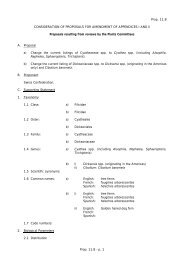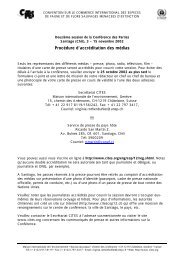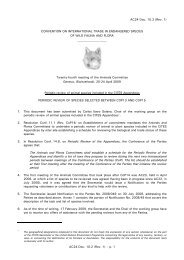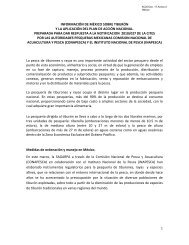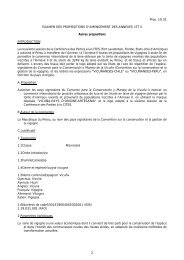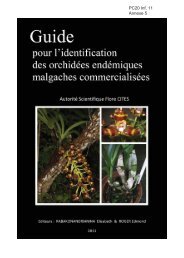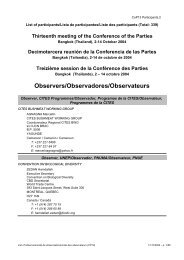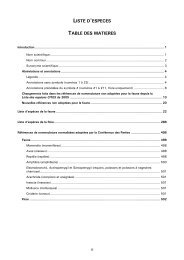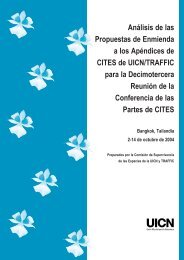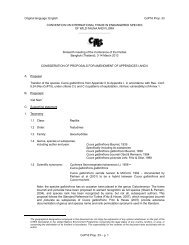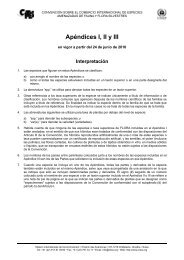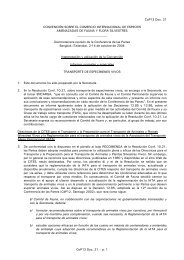Lamna nasus - Cites
Lamna nasus - Cites
Lamna nasus - Cites
You also want an ePaper? Increase the reach of your titles
YUMPU automatically turns print PDFs into web optimized ePapers that Google loves.
Draft Proposal to list <strong>Lamna</strong> <strong>nasus</strong> in Appendix II - prepared by Germany in January 2012<br />
5. Threats<br />
The principal threat to L. <strong>nasus</strong> worldwide is over-exploitation, in target and bycatch fisheries, which depleted<br />
the world’s largest North Atlantic stocks over 50 years ago (Figure 5). More recently, global reported<br />
porbeagle landings from bycatch and directed fisheries have decreased from 1 719t in 1999 to 722t in 2009,<br />
with the highest catches in 2009 from France (281t), Spain (239t), Canada (63t) and New Zealand (63t) (FAO<br />
FishStat 2011), although ICCAT/ICES (2009) notes that reported landings “grossly underestimate actual<br />
landings”. Canadian catch data indicates that porbeagle landings have progressively decreased, from a peak of<br />
1400 t in 1995, corresponding with decreasing TAC levels (Campana and Gibson 2008, Figure 20), and an EU<br />
zero quota was adopted in 2010. However, other fisheries are also declining, even in the absence of restrictive<br />
management (for example, in the southern hemisphere (Figure 20). This species is particularly vulnerable to<br />
fisheries because, in the absence of management, these target adults and juveniles of all age classes (Ministry<br />
of Fisheries 2006, Francis et al. 2007). Furthermore, the life history characteristics of Southern Ocean<br />
porbeagles make this population significantly more vulnerable to overfishing than the depleted North Atlantic<br />
populations.<br />
5.1 Directed fisheries<br />
Intensive directed fishing for the valuable meat of L. <strong>nasus</strong> was the major cause of 20 th Century population<br />
declines. ICES (2005) noted: “The directed fishery for porbeagle [in the Northeast Atlantic] stopped in the<br />
late 1970s due to very low catch rates. Sporadic small fisheries have occurred since that time. The high market<br />
value of this species means that a directed fishery would develop again if abundance increased.” A target<br />
fishery for the meat of L. <strong>nasus</strong> still operates in Canada, and short term opportunistic target fisheries occur in<br />
other States, in the absence of management, as and when aggregations are located. There are no high seas<br />
catch quotas for porbeagles although the 2009 ICCAT SCRS/ICES stock assessment meeting recommended<br />
that high seas fisheries should not target porbeagle. L. <strong>nasus</strong> used to be an important target game fish species<br />
for recreational fishing in Ireland and UK. The recreational fisheries in Canada, the US and New Zealand are<br />
very small.<br />
5.2 Incidental fisheries<br />
<strong>Lamna</strong> <strong>nasus</strong> is a valuable utilised ‘bycatch’ or secondary target of many fisheries, particularly longline<br />
pelagic fisheries for tuna and swordfish (Buencuerpo et al. 1998), but also gill nets, driftnets, trawls and<br />
handlines. Bycatch is often inadequately recorded in comparison with captures in target fisheries. The high<br />
value of porbeagle meat means that the whole carcass is usually retained and utilised, unless the hold space of<br />
vessels targeting high seas tuna and billfish is limited, when the fins alone may be retained (e.g. New Zealand<br />
and far seas longline fisheries for Southern Bluefin Tuna, and other pelagic fishing fleets operating in the<br />
Southern Hemisphere, see Compagno 2001). ICES (2005) noted: “effort has increased in recent years in<br />
pelagic longline fisheries for Bluefin Tuna (Japan, Republic of Korea and Taiwan Province of China) in the<br />
North East Atlantic. These fisheries may take porbeagle as a bycatch. This fishery is likely to be efficient at<br />
catching considerable quantities of this species.” This was confirmed by Campana and Gibson (2008).<br />
ICCAT/ICES (2009) warned that increased effort on the high seas could compromise stock recovery efforts.<br />
Despite the large amount of oceanic fishing activity that must take a bycatch of L. <strong>nasus</strong> in the Southern<br />
Hemisphere, landings reported to FAO only commenced in 1994 and are relatively low, with the exception of<br />
New Zealand, Spain and Uruguay. Japan’s porbeagle bycatch in southern ocean fisheries is not reported to<br />
FAO, but must be significant: porbeagle was the second most abundant species after blue shark and comprised<br />
5.5% of shark catches in the Japanese tuna fishery in Australian waters (Stevens and Wayte 2008)<br />
Spanish vessels used to take a bycatch in their longline swordfish fisheries, and Uruguay and other countries<br />
(some of which do not report to FAO) have a significant bycatch in longline swordfish and tuna fisheries in<br />
international waters off the Atlantic coast of South America (Domingo 2000, Domingo et al. 2001, Hazin et<br />
al. 2008).<br />
Important but largely unreported bycatch fisheries include demersal longlining and trawling for Patagonian<br />
Toothfish and Mackerel Icefish around Heard and Macdonald Islands and in the southern Indian Ocean (van<br />
Wijk and Williams 2003, Compagno 2001), and the artisanal and industrial longline swordfish fishery within<br />
and outside the Chilean EEZ, between 26–36ºS (E. Acuña unpublished data; Acuña et al. 2002), which<br />
records porbeagle. Hernandez et al. (2008) found that <strong>Lamna</strong> <strong>nasus</strong> made up 1.7% of all fins tested in the<br />
north-central Chilean shark fin trade. Overall catches of <strong>Lamna</strong> <strong>nasus</strong> by Argentina were 30,1 - 17,7 - 19,8 -<br />
69,7 t between 2003 and 2006 (source: INIDEP 2009) (these data do not appear in FISHSTAT), but porbeagle<br />
captures by the Argentinean fleet are probably now limited to incidental captures by three Patagonian<br />
Page 8 of 14<br />
AC26 Doc. 26.2, Annex 1 – p. 8<br />
AC26 Doc. 26.2<br />
Annex / Anexo /Annexe<br />
(English only / únicamente en inglés / seulement en anglais)




